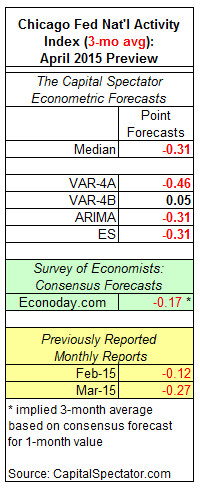
The three-month average of the Chicago Fed National Activity Index (CFNAI) is expected to slip a bit deeper into negative territory in the April update that’s scheduled for tomorrow (May 21), based on The Capital Spectator’s median point forecast for several econometric estimates. The projection for -0.31 is slightly below the -0.27 reading for March, which reflected a below-average pace of economic growth for the US relative to the historical trend. Only negative values below -0.70 indicate an “increasing likelihood” that a recession has started, according to guidelines from the Chicago Fed. Using today’s estimate for April as a guide, CFNAI’s three-month average is expected to remain at a rate of growth that’s below the historical trend but still above the tipping point that marks the start of a new recession.
A recent survey of economists by Econoday.com projects a moderately stronger but still-negative reading for CFNAI’s three-month average, based on the one-month estimate that’s used to calculate an expected three-month reading.
Here’s a closer look at the numbers, followed by brief definitions of the methodologies behind The Capital Spectator’s projections that are used to calculate the median forecast:

VAR-4A: A vector autoregression model that analyzes four economic time series to project the Chicago Fed National Activity Index: the Capital Spectator’s Economic Trend & Momentum Indexes, the Philadelphia Fed US Leading Indicator, and the Philadelphia Fed US Coincident Economic Activity Indicator. VAR analyzes the interdependent relationships of these series with CFNAI through history. The forecasts are run in R with the “vars” package.
VAR-4B: A vector autoregression model that analyzes four economic time series to project the Chicago Fed National Activity Index: US private payrolls, real personal income less current transfer receipts, real personal consumption expenditures, and industrial production. VAR analyzes the interdependent relationships of these series with CFNAI through history. The forecasts are run in R with the “vars” package.
















